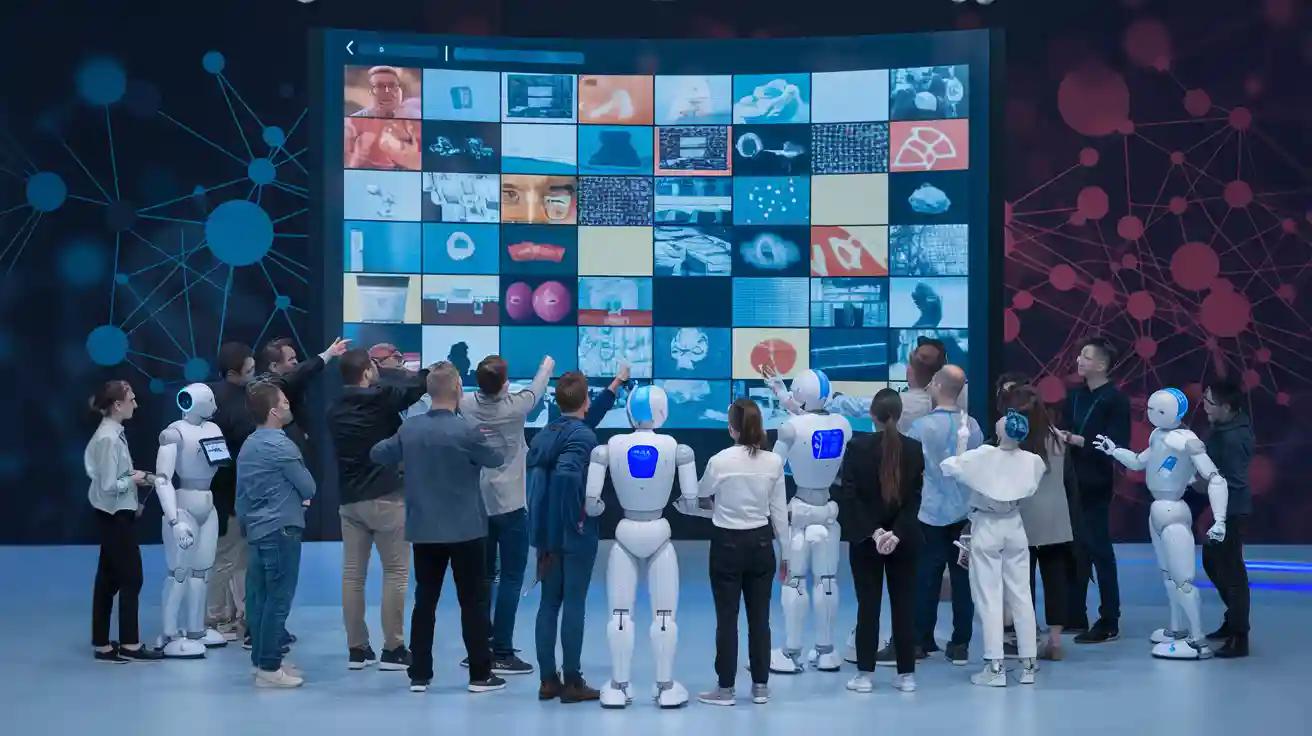
Collaborative filtering in machine vision describes a recommender system approach that predicts preferences or decisions for visual data by analyzing patterns in user interactions. This technique uses numerical similarity measures, including cosine similarity and Pearson correlation coefficient, to compare users or items within a utility matrix. The recommender evaluates these scores to generate recommendations, often applying matrix factorization for improved accuracy. Collaborative Filtering machine vision system performance relies on statistical evaluation metrics such as Recall and RMSE, which demonstrate both the effectiveness and challenges of these collaborative recommender systems in delivering accurate recommendations.
Key Takeaways
- Collaborative filtering predicts user preferences by analyzing patterns in user ratings and interactions with images or videos.
- The system uses user-based and item-based approaches to find similarities and generate personalized recommendations.
- Machine vision systems combine matrix factorization and neural networks to handle complex data and improve recommendation accuracy.
- Advanced techniques like deep learning, NLP, and sequence modeling help extract meaningful features from visual and textual data.
- Collaborative filtering boosts user engagement and business growth by delivering relevant recommendations that adapt to changing preferences.
Collaborative Filtering Basics
Core Concepts
Collaborative filtering stands as a key approach in many recommender systems. This method uses the collective behavior of users to make recommendations. The system collects user ratings and builds a utility matrix. Each row represents a user, and each column represents an item, such as an image or video. The recommender looks for similarities between users or items by comparing their rating patterns.
A similarity matrix helps the system measure how closely users or items relate to each other. The system uses user similarity and item similarity to find patterns. When the recommender finds high similarities, it predicts that users will like similar items. The system then generates recommendations based on these predictions.
Note: Collaborative filtering does not require detailed information about the items. It relies on user ratings and similarities within the data.
Types and Approaches
Collaborative filtering comes in two main types: user-based and item-based. Each type uses a different approach to generate recommendations.
- User-Based Collaborative Filtering: The recommender finds users with similar rating histories. If two users rate items in a similar way, the system assumes they will like similar items in the future.
- Item-Based Collaborative Filtering: The recommender looks for items that receive similar ratings from many users. If a user likes one item, the system recommends other items with similar rating patterns.
A table can help compare these approaches:
| Approach | Focus | Uses Similarity Matrix | Example Use Case |
|---|---|---|---|
| User-Based | Users | Yes | Social media feeds |
| Item-Based | Items | Yes | Product recommendations |
Collaborative filtering algorithms use these approaches to process data and generate recommendations. The system updates the similarity matrix as new user ratings arrive. This process helps the recommender stay accurate and relevant.
Collaborative Filtering Machine Vision System

System Structure
A collaborative filtering machine vision system uses a specialized architecture to handle visual data and generate accurate recommendations. The system begins by collecting user ratings for images or videos. Each user and item receives a unique identifier, often represented as a one-hot encoded vector. This approach allows the recommender to process large amounts of data efficiently.
The system uses embedding layers to reduce the dimensionality of these sparse vectors. Embedding helps the recommender capture important patterns in user ratings and item ratings. The core of the collaborative filtering machine vision system combines matrix factorization and multi-layer perceptron (MLP) models. Matrix factorization uncovers hidden relationships between users and items, while the MLP captures complex patterns in the data.
A typical system structure includes several dense layers, usually between four and six. Each layer contains up to 100 neurons, but very sparse data may require up to 256 neurons per layer. The system uses ReLU activation functions in hidden layers to improve learning. Dropout and L2 regularization prevent overfitting, ensuring the recommender remains accurate as new data arrives.
The final layer, often called NeuCF, merges the outputs from matrix factorization and the MLP. This layer produces the prediction probability for each user-item pair. The system uses the ADAM optimizer for fast convergence and sometimes fine-tunes with SGD. Binary cross-entropy serves as the loss function, helping the recommender make precise rating predictions.
The collaborative filtering machine vision system evaluates its performance using metrics like Top-k Hit Rate and Normalized Discounted Cumulative Gain (NDCG). These metrics measure how well the system ranks relevant items for each user.
| Component/Aspect | Details/Statistics |
|---|---|
| Input Data | One-hot encoded user and item IDs; conversion of explicit feedback to implicit feedback |
| Embedding Layers | Reduce dimensionality of sparse one-hot vectors for both users and items |
| Model Architecture | Combination of Matrix Factorization (MF) and Multi-Layer Perceptron (MLP) models |
| MLP Layers | 4-6 dense layers, typically under 100 neurons per layer; up to 6 layers with 256 neurons for sparse data |
| Activation Functions | ReLU in hidden layers; sigmoid avoided due to saturation issues |
| Regularization Techniques | Dropout and L2 kernel regularization applied to prevent overfitting |
| Final Layer (NeuCF) | Concatenation of MF and MLP outputs followed by a dense layer producing prediction probability |
| Optimization Methods | ADAM optimizer preferred; sometimes fine-tuned with SGD |
| Loss Function | Binary cross-entropy (log loss) commonly used |
| Evaluation Metrics | Top-k Hit Rate and NDCG with leave-one-out evaluation |
This structure allows the collaborative filtering machine vision system to handle high-dimensional data and complex user-item interactions. The recommender can adapt to new user ratings and update its predictions quickly.
Data and Features
The collaborative filtering machine vision system relies on a rich set of data and features to make accurate recommendations. The system processes both explicit and implicit user ratings. Explicit ratings come from direct feedback, such as a user giving a star rating to an image. Implicit ratings are inferred from user actions, like viewing or sharing a video.
To extract meaningful features from visual data, the system uses several advanced techniques:
- Deep learning models analyze images and videos to capture visual patterns.
- Matrix factorization reduces the dimensionality of user-item interaction data, revealing hidden factors that influence preferences.
- The recommender builds a similarity matrix to compare users and items, using cosine similarity to measure how closely their rating patterns match.
- Natural Language Processing (NLP) extracts information from textual metadata, such as image descriptions or user comments.
- TF-IDF vectorization converts text into numerical vectors, allowing the system to analyze item attributes quantitatively.
- The system uses user-item interaction matrices to compute similarities and generate recommendations.
- LSTM networks model the sequence of user interactions, capturing how preferences change over time.
The collaborative filtering machine vision system updates its similarity matrix as new user ratings arrive. This process ensures the recommender stays relevant and accurate. The system uses both user similarity and item similarity to find patterns in the data. When the recommender detects high similarities, it generates rating predictions for items the user has not yet rated.
The collaborative filtering machine vision system depends on accurate feature extraction and similarity calculations. These steps allow the recommender to deliver personalized recommendations and improve rating predictions.
The system also incorporates regular feedback to refine its predictions. By analyzing user ratings and similarities, the collaborative filtering machine vision system adapts to changing preferences and new visual content. This approach helps the recommender provide relevant recommendations, even as the data grows and evolves.
Recommendation Algorithms
Applications and Benefits

Collaborative filtering in machine vision helps systems recommend images and videos by learning from user patterns. These algorithms boost user engagement and drive business growth, with retailers seeing up to a 35% revenue increase. New AI tools like federated learning and AutoML make these systems more private and easier to use.
| Trend | Impact |
|---|---|
| Multi-modal data | Deeper product understanding |
| AI integration | Smarter, faster recommendations |
| Ethical focus | Fairness and diversity in recommendations |
Machine vision and collaborative filtering will shape smarter, more responsible systems in the future.
FAQ
What is the main advantage of collaborative filtering in machine vision?
Collaborative filtering helps systems learn from user behavior. This method improves recommendations for images and videos. It adapts quickly to new data and does not need detailed item information.
How does collaborative filtering handle new users or items?
The system faces the "cold start" problem with new users or items. It uses available interactions or asks for initial feedback. Some systems combine collaborative filtering with content-based methods to improve early recommendations.
Can collaborative filtering work with only visual data?
Collaborative filtering usually needs user interaction data, such as ratings or clicks. Visual features alone do not provide enough information. Systems often combine visual analysis with user feedback for better results.
What metrics measure the performance of these systems?
| Metric | Purpose |
|---|---|
| Recall | Finds relevant recommendations |
| RMSE | Measures prediction accuracy |
| NDCG | Ranks item relevance |
These metrics help evaluate how well the system recommends visual content.
See Also
How Filtering Enhances Accuracy In Machine Vision Systems
Understanding Optical Filters’ Impact On Contemporary Machine Vision
The Use Of Synthetic Data Within Machine Vision Technology
An Overview Of Few-Shot And Active Learning Methods In Vision









